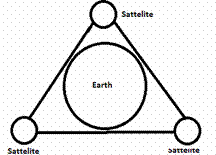types
Geostationary or geosynchronous satellites:
GEO satellites are synchronous with respect to earth. Looking from a fixed point from  Earth, these satellites appear to be stationary. These satellites are placed in the space in such a way that only three satellites are sufficient to provide connection throughout the surface of the Earth . The orbit of these satellites is circular. Lifetime expectancy of these satellites is 15 years.
Earth, these satellites appear to be stationary. These satellites are placed in the space in such a way that only three satellites are sufficient to provide connection throughout the surface of the Earth . The orbit of these satellites is circular. Lifetime expectancy of these satellites is 15 years.
There are three conditions which lead to geostationary satellites :
1) The satellite should be placed 37,786 kms (approximated to 36,000 kms) above the surface of the earth.
2) These satellites must travel in the rotational speed of earth, and in the direction of motion of earth, that is eastward.
3) The inclination of satellite with respect to earth must be 0º.
These satellites are used for TV and radio broadcast, weather forecast and also, these satellites are operating as backbones for the telephone networks.
Disadvantages of GEO: Northern or southern regions of the Earth (poles) have more problems receiving these satellites due to the low elevation above latitude of 60°, i.e., larger antennas are needed in this case. Shading of the signals is seen in cities due to high buildings and the low elevation further away from the equator limit transmission quality. The biggest problem for voice and also data communication is the high latency as without having any handovers, the signal has to at least travel 72,000 kms. Due to the large footprint, either frequencies cannot be reused or the GEO satellite needs special antennas focusing on a smaller footprint. Transferring a GEO into orbit is very expensive.
 Earth, these satellites appear to be stationary. These satellites are placed in the space in such a way that only three satellites are sufficient to provide connection throughout the surface of the Earth . The orbit of these satellites is circular. Lifetime expectancy of these satellites is 15 years.
Earth, these satellites appear to be stationary. These satellites are placed in the space in such a way that only three satellites are sufficient to provide connection throughout the surface of the Earth . The orbit of these satellites is circular. Lifetime expectancy of these satellites is 15 years. There are three conditions which lead to geostationary satellites :
1) The satellite should be placed 37,786 kms (approximated to 36,000 kms) above the surface of the earth.
2) These satellites must travel in the rotational speed of earth, and in the direction of motion of earth, that is eastward.
3) The inclination of satellite with respect to earth must be 0º.
These satellites are used for TV and radio broadcast, weather forecast and also, these satellites are operating as backbones for the telephone networks.
Disadvantages of GEO: Northern or southern regions of the Earth (poles) have more problems receiving these satellites due to the low elevation above latitude of 60°, i.e., larger antennas are needed in this case. Shading of the signals is seen in cities due to high buildings and the low elevation further away from the equator limit transmission quality. The biggest problem for voice and also data communication is the high latency as without having any handovers, the signal has to at least travel 72,000 kms. Due to the large footprint, either frequencies cannot be reused or the GEO satellite needs special antennas focusing on a smaller footprint. Transferring a GEO into orbit is very expensive.
Low Earth Orbit Satllites:
These satellites are placed 500-1500 kms above the surface of the earth. As LEOs circulate on a lower orbit, they exhibit a much shorter period that is 95 to 120 minutes. LEO systems try to ensure a high elevation for every spot on earth to provide a high quality communication link. Each LEO satellite will only be visible from the earth for around ten minutes.
These satellites are mainly used in remote sensing and providing mobile communication services (due to lower latency).
Disadvantages: The biggest problem of the LEO concept is the need for many satellites if global coverage is to be reached. One general problem of LEOs is the short lifetime of about five to eight years due to atmospheric drag and radiation from the inner Van Allen belt. For a lifetime of eight years, a new satellite would be needed every two months. ype the paragraph content here
Disadvantages: The biggest problem of the LEO concept is the need for many satellites if global coverage is to be reached. One general problem of LEOs is the short lifetime of about five to eight years due to atmospheric drag and radiation from the inner Van Allen belt. For a lifetime of eight years, a new satellite would be needed every two months. ype the paragraph content here